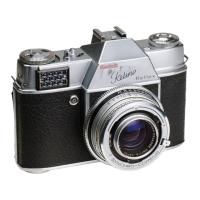If the scene is to be sharp from a point close to the lens to some other point well away from it, you should
choose the stop that will yield the necessary depth of field (p.40) and then pair it with the shutter speed
necessary for the correct exposure.
If the light is very poor, the chances are that you may not be able to cope with either extremely fast or
particularly deep subjects. Yet your choice in putting shutter speed or depth of field first should still be governed
by what you value most about the picture you propose to take.
Exposure nowadays is no problem at all. You can arrive at the right exposure by guessing it, measuring it, or
just leaving it to the camera. But to hit it off in such a way that it will produce the picture you want is still a
matter of intelligent judgement.
Time Exposures
When the light is very weak, especially when you have to use a small stop, even the slowest shutter speed of 1
sec. may be too short. In that case, you need time exposures. Set the shutter to B and press the release
button. The shutter now remains open for any length of time until you let go of the release button.
For such time exposures, the camera must be mounted on a firm support such as a tripod.
It is safest to release the shutter with the help of a cable release to avoid shaking the camera. This release
screws into the bush in the centre of the body release button.
For long time exposures, where the shutter is to remain open for longer than you can conveniently keep the
release depressed, use a cable release with a lock. To make the exposure set the shutter to B, press the cable
release plunger with the locking plate lifted. The shutter will now remain open until the locking plate is
depressed. On cable releases with locking screws, tighten the screw on pressing the plunger and undo the screw
to close the shutter.
The Self-timer
The Retina Reflex models carry a delayed action release or self-timer. This is usually controlled by the same
lever as the flash synchronization (p.42). When you press the release button with the self-timer in operation,
the shutter only goes off after a delay of 8-10 seconds and you have time to take your place in your own
picture. The camera must, of course, be mounted on a tripod.
USING THE EXPOSURE METER
For normal meter readings. point the camera with the cell at the
subject by observing the latter on the finder screen. With
landscapes and other open views point the camera slightly
downwards to exclude excessively bright sky areas which might give
misleading results.
For accurate readings against very light or very dark backgrounds,
go close to the subject with the camera so that the meter cell just
takes in the important part of subject.

